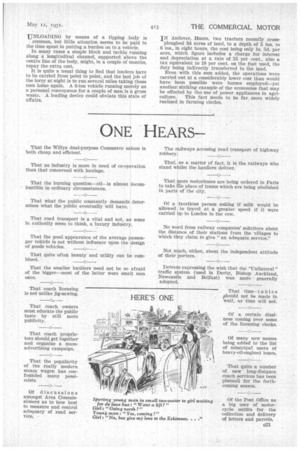LOOSE LEAVES
Page 82

Page 83

If you've noticed an error in this article please click here to report it so we can fix it.
people have any idea of the total loads carried annually by motor vehicles; therefore an estimate may be of interest. The average load of goods vehicles throughout the country is comparatively small, amounting to only 1 ton against an average of 25 cwt. in America.
If each vehicle be considered to average 50 miles per day for 300 days per year this gives a figure of 15,000 miles' actual running, or 15,000 ton-miles per annum. Taking the numbers of goods-carrying vehicles registered in this country as 350,000, this gives a total annual ton-mileage of 5,250,000,000.
A. PARTICULARLY interesting little publication is Nickel, published by the Mond Nickel Co., Ltd., Millbank, London, S.W.1. The latest edition concerns nickel-alloy steels, and is a summary of their properties and applications. Such steels are employed to an increasing extent in the construction of commercial vehicles, and we note that mention is made of the 3.5 per cent. nickel-steel frame used on the A.E.C. Regent chassis.
THE task of bus conductors in Shanghai is rather more taxing than in this country, because the Chinese use copper coinage of extremely low value. For instance, a silver dollar, which is worth a little e20 under is., may be made up of some 300 copper or brass coins, and each is nearly as big as an English penny.
For this reason the conductor has to carry a large leather bag, which is invariably filled before the day is out, so that the contents have to be poured into a sack attached to a corner of the bus. The weight of the conductor's satchel can well be imagined.
Last year the Shanghai General Omnibus Co., which operates over 100 buses, collected 385,500,000 copper coins from passengers, the weight of the 12 months' earnings being nearly 3,000 tons.
IT will be only a short time be.fore every large
garage housing a commercial fleet and every commercial-motor factory will be equipped with a practical brake-testing installation. In the past the hitand-miss methods have been the only ones adopted, as a rule. A recent test on the new installation at the Tecalemit headquarters on the Great West Road revealed in a striking manner how feeble a result is obtained, even by the expert mechanic, when relying upon old-fashioned methods of adjusting fourwheel brakes. There is a very great difference between equalizing the braking effort and equalizing the retarding efficiency of the brakes on each wheel.
UNLOADING by means of a tipping body is common, but little attention seems to be paid to the time spent in putting a burden on to a vehicle.
In many cases a simple block and tackle running along a longitudinal channel, supported above the centre line of the body, might, in a couple of months, repay the extra cost.
It is quite a usual thing to find that loaders have to be carried from point to point, and the last job of the lorry at night is to run several miles taking these men hdme again. A 6-ton vehicle running merely as a personal conveyance for a couple of men is a gross waste. A loading device could obviate this state of affairs.
IN Andover, fants, two tractors recently cross ploughed 34 acres of land, to a depth of 5 ins. to 6 ins., in eight hours, the cost being only is. 5d. per acre, which figure includes a charge for interest and depreciation at a rate of 25 per cent., also a tax equivalent to 18 per cent, on the fuel used, the duty being indirectly transferred to the land.
Even with this sum added, the operations were carried out at a considerably lower cost than would have been possible were horses employed—yet another striking example of the economies that may be effected by the use of power appliances in agri culture. This fact needs to be far more widely realized in farming circles.




































































































































































































